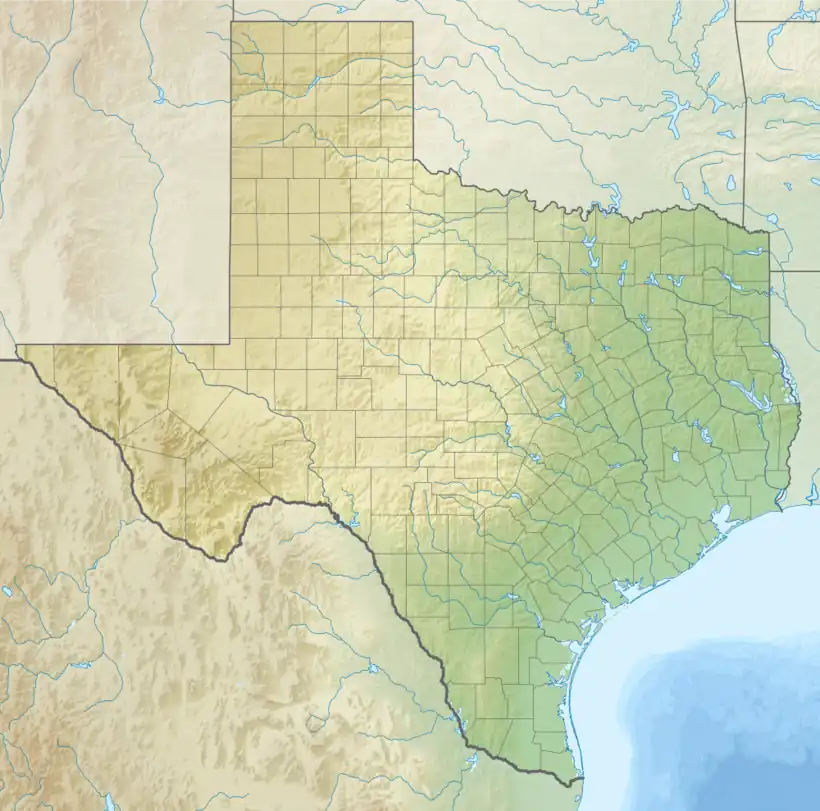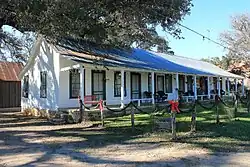Sisterdale, Texas | |
|---|---|
.jpg.webp) | |
 Sisterdale Location in Texas and the United States  Sisterdale Sisterdale (the United States) | |
| Coordinates: 29°58′23″N 98°43′15″W / 29.97306°N 98.72083°W | |
| Country | United States |
| State | Texas |
| County | Kendall |
| Elevation | 1,280 ft (390 m) |
| Time zone | UTC-6 (Central (CST)) |
| • Summer (DST) | UTC-5 (CDT) |
| ZIP code | 78006 (Boerne) |
| Area code | 830 |
| FIPS code | 48-68060[2] |
| GNIS feature ID | 1347179[1] |
Sisterdale is an unincorporated farming and ranching community established in 1847 and located 13 miles (21 km) north of Boerne in Kendall County, in the U.S. state of Texas. The community is located in the valley of Sister Creek.[3] The elevation is 1,280 feet (390 m).[4]
Community
Sisterdale[5] was settled in 1847 by German surveyor and free thinker Nicolaus Zink.[6] Originally part of Comal County, Sisterdale became part of Kendall County when the latter was formed in 1862.
Among the settlers were German pioneers Fritz and Betty Holekamp,[7] geographer Ernst Kapp;[8] Anhalt Premier progeny[9] Baron Ottomar von Behr;[10] journalist Carl Adolph Douai;[11] August Siemering[12] who later founded the San Antonio Express News; author, journalist and diplomat Julius Fröbel; future Wall Street financial wizard Gustav Theissen;[9] and Edgar von Westphalen,[13][14][15] brother to Jenny von Westphalen who was married to Karl Marx.[16]
The first child born in Sisterdale (and in Kendall County) was Julius Holekamp on June 10, 1849, to Fritz and Betty Holekamp.[17]
One notable early colonist was Edward Degener, future Republican congressman from Texas during the Reconstruction era. Degener's sons Hugo and Hilmar died during the American Civil War in the Nueces massacre. To honor their memory, Degener along with Eduard Steves and William Heuermann purchased land for the establishment of the German-language Treue der Union Monument, which was built in 1866 and listed on the National Register of Historic Places in 1978.[18]
Also among the settlers was Julius Dresel (or Dressel), a member of the German Chambers of Deputies,[9][19] who was the first to plant a Sisterdale vineyard. His brother Emil Dresel and partner Jacob Gundlach later established the Rhein Farm Vineyard in Sonoma, California. Julius later moved to San Antonio. Upon the death of brother Emil, who bequeathed Julius his share of the Sonoma vineyard, Julius moved his family to California.[20]
The community received a post office in 1851, and Ottomar W. Behr was the first postmaster.[21]
Sisterdale eventually had a school house, a gas station-garage, a general store, a cotton gin, and a factory for making cypress shingles. The old 1885 cotton gin in Sisterdale has been restored and is today home to Sister Creek Vineyards.[22]
Historical population
| Census | Pop. | Note | %± |
|---|---|---|---|
| 1880 | 150 | — | |
| 1910 | 26 | — | |
| 1920 | 50 | 92.3% | |
| 1970 | 63 | — | |
| 1980 | 100 | 58.7% | |
| 1990 | 60 | −40.0% | |
| 2000 | 25 | −58.3% | |
| 2010 | 110 | 340.0% |
Source: Texas Escapes [23]
Free thinkers
Sisterdale was one of the Latin Settlements, resulting from the Revolutions of 1848 in the German states. Those who came were Forty-Eighters, intellectual liberal abolitionists who enjoyed conversing in Latin and believed in utopian ideals that guaranteed basic human rights to all.[9] They reveled in passionate conversations about literature, music and philosophy.[24]
The free thinkers petitioned the Texas Legislature in 1853 for a charter to operate a German-English college to be built at Sisterdale, but the petition did not come to fruition.[25]
Irene Marschall King, granddaughter of John O. Meusebach, remembered how her grandfather enjoyed the intellectual stimulation of visits to Sisterdale,[24] where a man of his aristocratic background could relate to such cultured free thought discourse, and where the air filled with concert music, singing, dancing and an ambience of general Gemütlichkeit.
In 1853, August Siemering was elected secretary, and Ernst Kapp the president, of the freethinker abolitionist organization Der Freie Verein (The Free Society),[26][27] which called for a meeting of abolitionist German Texans[28] in conjunction with the May 14, 1854, Staats-Saengerfest (State Singing Festival) in San Antonio. Wilhelm Victor Keidel was elected vice president of the convention, which adopted a political, social and religious platform,[29] including:
1) Equal pay for equal work; 2) Direct election of the President of the United States; 3) Abolition of capital punishment; 4) Slavery is an evil, the abolition of which is a requirement of democratic principles...; 5) Free schools – including universities – supported by the state, without religious influence; and 6) Total separation of church and state.
One of the most tragic episodes in the history of Kendall County happened in 1862 after Texas joined the Confederacy. The Confederacy considered the free thinkers of Sisterdale and like communities to be a threat.[28] A number of Kendall County Germans became conscientious objectors to the military draft. Confederate authorities reacted by imposing martial law on central Texas. 61 conscientious objectors attempted to flee to Mexico. Confederate irregular James Duff[30] and his Duff's Partisan Rangers pursued them. At the Nueces River, 34 were killed, and some executed after being taken prisoner. In 1866, Kendall County erected the Treue der Union Monument ("Loyalty to the Union") monument[31][32] dedicated to the German Texans slain at the Nueces massacre.
Darmstadt Society of Forty
Some of the early settlers in Sisterdale migrated from the collapsed Fisher–Miller Land Grant experimental colonies of the Darmstadt Society of Forty.
Sisterdale Valley District
Sisterdale Valley District | |
 Sisterdale Bed and Breakfast | |
| Location | FM 1376, Sisterdale, Texas |
|---|---|
| Area | 2,893 acres (1,171 ha) |
| NRHP reference No. | 75001996[33] |
| Added to NRHP | January 8, 1975 |
The Sisterdale Valley District is a 2,893-acre (1,171 ha) historic district in Sisterdale, Texas that was listed on the U.S. National Register of Historic Places in 1975. It included 15 contributing buildings and six other contributing structures.[33] The historic buildings include an 1890s dance hall.[34]
Photo gallery
 Grounds of the Sisterdale Dance Hall & Opera House
Grounds of the Sisterdale Dance Hall & Opera House Original Settler Cabin Circa 1859
Original Settler Cabin Circa 1859 Sisterdale Dance Hall & Opera House
Sisterdale Dance Hall & Opera House Sister Creek Vineyards
Sister Creek Vineyards Sisterdale Cemetery at RM 473 and 1376
Sisterdale Cemetery at RM 473 and 1376.jpg.webp) Sisterdale Bar
Sisterdale Bar Marlowe Candle Company
Marlowe Candle Company
See also
References
- 1 2 U.S. Geological Survey Geographic Names Information System: Sisterdale, Texas
- ↑ "U.S. Census website". United States Census Bureau. Retrieved January 31, 2008.
- ↑ Sister Creek from the Handbook of Texas Online. Retrieved 30 April 2010. Texas State Historical Association
- ↑ "Geographical Names Information System, Sisterdale". U.S. Dept of the Interior. Retrieved April 30, 2010. U.S. Dept of the Interior
- ↑ Syers, Ed (October 18, 1964). "Sisterdale Just Spread Out". The Victoria Advocate.
- ↑ Ragsdale, Crystal Sessie: Zinc, Nicolaus from the Handbook of Texas Online. Retrieved 30 April 2010. Texas State Historical Association
- ↑ Morgenthaler, Jefferson; The German Settlement of the Texas Hill Country; 2011
- ↑ Jordan, Terry G.: Kapp, Ernst from the Handbook of Texas Online. Retrieved 30 April 2010. Texas State Historical Association
- 1 2 3 4 Scharf, Edwin E. "Freethinkers of the Early Texas Hill Country". Freethinkers Association of Central Texas. Archived from the original on February 19, 2009. Retrieved May 9, 2010. Freethinkers Association of Central Texas
- ↑ Ragsdale, Paul C.: Von Behr, Ottmar from the Handbook of Texas Online. Retrieved 30 April 2010. Texas State Historical Association
- ↑ Sibley, Marilyn M.: Douai, Carl Daniel Adolph from the Handbook of Texas Online. Retrieved 30 April 2010. Texas State Historical Association
- ↑ Gold, Ella: Siemering, August from the Handbook of Texas Online. Retrieved 30 April 2010. Texas State Historical Association
- ↑ Haarman, Viola; Conzen, Michael P. (2000). Cultural Encounters with the Environment. Rowman & Littlefield Publishers, Inc. pp. 39, 45, 56. ISBN 978-0-7425-0105-8.
- ↑ "Edgar von Westphalen". Marxists.org. Retrieved May 30, 2010. Roe Hampton University-London
- ↑ "Jenny von Westphalen". Marxists.org. Retrieved May 30, 2010. Roe Hampton University-London
- ↑ Simon, B. "Marx, Karl-Julius Fröbel, Julius". Roe Hampton University-London. Retrieved April 30, 2010. Roe Hampton University-London
- ↑ Ransleben, Guido E.; A Hundred Years of Comfort in Texas; 1954
- ↑ "National Register of Historic Places-Kendall Co, Tx". U.S. Dept. of Interior, the National Park Service. Retrieved February 2, 2011.
- ↑ "Wine Industry Pioneers". The Wine Institute. Retrieved May 30, 2010. The Wine Institute
- ↑ Guinn, James Miller (1902). History of the State of California and Biographical Record of Coast Counties, California: An Historical Story of the State's Marvelous Growth from Its Earliest Settlement to the Present Time. Chapman Publishing Company. p. 1050.
- ↑ "Sisterdale Postmasters". Jim Wheat. Retrieved April 29, 2010.Jim Wheat
- ↑ "Sisterdale Creek Vineyards". Retrieved April 29, 2010.
- ↑ "Sisterdale, Texas". www.texasescapes.com. Retrieved February 26, 2022.
- 1 2 Kennedy, Ira. "German Intellectuals on the Texas Frontier". TexFiles. Retrieved April 30, 2010.
- ↑ Scharf, Edwin E. "Freethinkers of the Early Texas Hill Country". Free Thinkers Association of Texas. Retrieved April 30, 2010.
- ↑ Goyne, Minetta Algelt (1982). Lone Star and Double Eagle: Civil War Letters of a German-Texas Family. Texas Christian Univ Press. p. 14. ISBN 978-0-912646-68-8.
- ↑ Puglisi Jr., Richard L. "Bexar County Chief Justice August Siemering, 1830–1883". University of the Incarnate Word. Retrieved May 9, 2010. University of the Incarnate Word
- 1 2 Biesele, Rudolph L.: German Attitude Toward the Civil War from the Handbook of Texas Online. Retrieved 9 May 2010. Texas State Historical Association
- ↑ Biesele, R L. "The Texas State Convention of Germans in 1854". The Texas State Historical Association. Retrieved November 22, 2010. The Texas State Historical Association
- ↑ Shook, Robert W.: Duff, James from the Handbook of Texas Online. Retrieved 30 April 2010. Texas State Historical Association
- ↑ "Treue der Union Monument". Texas Escapes – Blueprints For Travel, LLC. Retrieved April 30, 2010. Texas Escapes – Blueprints For Travel, LLC.
- ↑ "Treue der Union Monument". TexGenWeb, Kendall Co. Archived from the original on February 26, 2012. Retrieved April 30, 2010. TexGenWeb, Kendall Co
- 1 2 "National Register Information System". National Register of Historic Places. National Park Service. July 9, 2010.
- ↑ "Sisterdale Valley District".
- ↑ Joe Cooper (2009). "Sisterdale".
- ↑ "Sisterdale". RootsWeb.com.
- ↑ Glen E. Lich. "Handbook of Texas Online: Sisterdale, TX". Texas State Historical Association. Retrieved September 8, 2013.
- ↑ "Sisterdale".
- ↑ "Sisterdale Cemetery".
Further reading
- Syers, Ed (October 18, 1964). "Sisterdale Just Spread Out". The Victoria Advocate.
- Haarman, Viola; Conzen, Michael P (2000). "The Clash of Utopias: Sisterdale and the Six-Sided Struggle for the Texas Hill Country". Cultural Encounters with the Environment. Rowman & Littlefield Publishers, Inc. pp. 39–58. ISBN 978-0-7425-0105-8.


